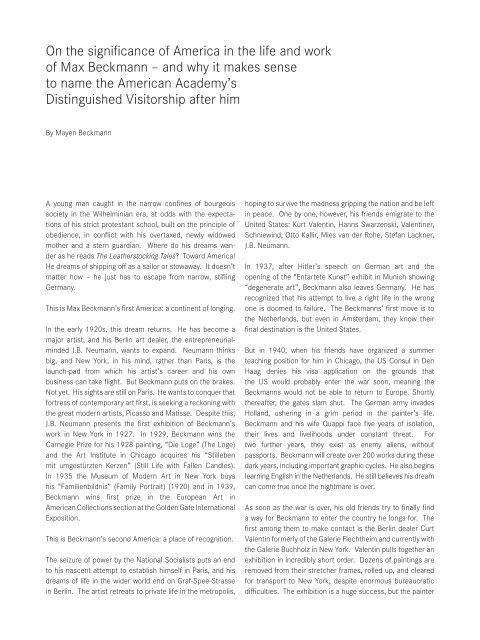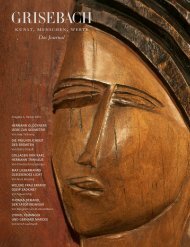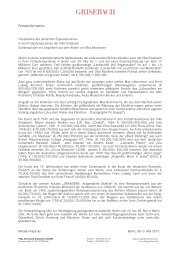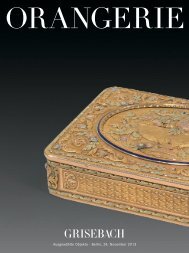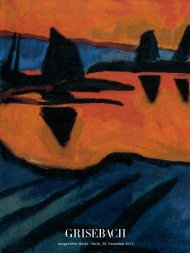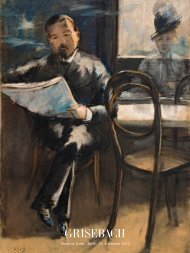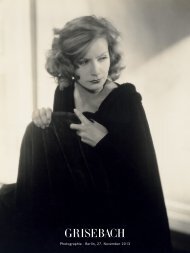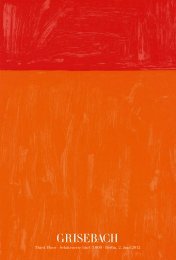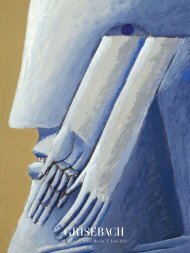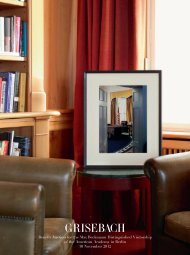Max Beckmann Distinguished Visitorship - Villa Grisebach
Max Beckmann Distinguished Visitorship - Villa Grisebach
Max Beckmann Distinguished Visitorship - Villa Grisebach
Create successful ePaper yourself
Turn your PDF publications into a flip-book with our unique Google optimized e-Paper software.
On the significance of America in the life and work<br />
of <strong>Max</strong> <strong>Beckmann</strong> – and why it makes sense<br />
to name the American Academy’s<br />
<strong>Distinguished</strong> <strong>Visitorship</strong> after him<br />
By Mayen <strong>Beckmann</strong><br />
A young man caught in the narrow confines of bourgeois<br />
society in the Wilhelminian era, at odds with the expectations<br />
of his strict protestant school, built on the principle of<br />
obedience, in conflict with his overtaxed, newly widowed<br />
mother and a stern guardian. Where do his dreams wander<br />
as he reads The Leatherstocking Tales? Toward America!<br />
He dreams of shipping off as a sailor or stowaway. It doesn’t<br />
matter how – he just has to escape from narrow, stifling<br />
Germany.<br />
This is <strong>Max</strong> <strong>Beckmann</strong>’s first America: a continent of longing.<br />
In the early 1920s, this dream returns. He has become a<br />
major artist, and his Berlin art dealer, the entrepreneurialminded<br />
J.B. Neumann, wants to expand. Neumann thinks<br />
big, and New York, in his mind, rather than Paris, is the<br />
launch-pad from which his artist’s career and his own<br />
business can take flight. But <strong>Beckmann</strong> puts on the brakes.<br />
Not yet. His sights are still on Paris. He wants to conquer that<br />
fortress of contemporary art first, is seeking a reckoning with<br />
the great modern artists, Picasso and Matisse. Despite this,<br />
J.B. Neumann presents the first exhibition of <strong>Beckmann</strong>’s<br />
work in New York in 1927. In 1929, <strong>Beckmann</strong> wins the<br />
Carnegie Prize for his 1928 painting, “Die Loge” (The Loge)<br />
and the Art Institute in Chicago acquires his “Stilleben<br />
mit umgestürzten Kerzen” (Still Life with Fallen Candles).<br />
In 1935 the Museum of Modern Art in New York buys<br />
his “Familienbildnis” (Family Portrait) (1920) and in 1939,<br />
<strong>Beckmann</strong> wins first prize in the European Art in<br />
American Collections section at the Golden Gate International<br />
Exposition.<br />
This is <strong>Beckmann</strong>’s second America: a place of recognition.<br />
The seizure of power by the National Socialists puts an end<br />
to his nascent attempt to establish himself in Paris, and his<br />
dreams of life in the wider world end on Graf-Spee-Strasse<br />
in Berlin. The artist retreats to private life in the metropolis,<br />
10<br />
Korr<br />
hoping to survive the madness gripping the nation and be left<br />
in peace. One by one, however, his friends emigrate to the<br />
United States: Kurt Valentin, Hanns Swarzenski, Valentiner,<br />
Schniewind, Otto Kallir, Mies van der Rohe, Stefan Lackner,<br />
J.B. Neumann.<br />
In 1937, after Hitler’s speech on German art and the<br />
opening of the “Entartete Kunst” exhibit in Munich showing<br />
“degenerate art”, <strong>Beckmann</strong> also leaves Germany. He has<br />
recognized that his attempt to live a right life in the wrong<br />
one is doomed to failure. The <strong>Beckmann</strong>s’ first move is to<br />
the Netherlands, but even in Amsterdam, they know their<br />
final destination is the United States.<br />
But in 1940, when his friends have organized a summer<br />
teaching position for him in Chicago, the US Consul in Den<br />
Haag denies his visa application on the grounds that<br />
the US would probably enter the war soon, meaning the<br />
<strong>Beckmann</strong>s would not be able to return to Europe. Shortly<br />
thereafter, the gates slam shut. The German army invades<br />
Holland, ushering in a grim period in the painter’s life.<br />
<strong>Beckmann</strong> and his wife Quappi face five years of isolation,<br />
their lives and livelihoods under constant threat. For<br />
two further years, they exist as enemy aliens, without<br />
passports. <strong>Beckmann</strong> will create over 200 works during these<br />
dark years, including important graphic cycles. He also begins<br />
learning English in the Netherlands. He still believes his dream<br />
can come true once the nightmare is over.<br />
As soon as the war is over, his old friends try to finally find<br />
a way for <strong>Beckmann</strong> to enter the country he longs for. The<br />
first among them to make contact is the Berlin dealer Curt<br />
Valentin formerly of the Galerie Flechtheim and currently with<br />
the Galerie Buchholz in New York. Valentin pulls together an<br />
exhibition in incredibly short order. Dozens of paintings are<br />
removed from their stretcher frames, rolled up, and cleared<br />
for transport to New York, despite enormous bureaucratic<br />
difficulties. The exhibition is a huge success, but the painter


